Input interpretation

FeCl_3 iron(III) chloride + MgO magnesium oxide ⟶ Fe_2O_3 iron(III) oxide + MgCl_2 magnesium chloride
Balanced equation
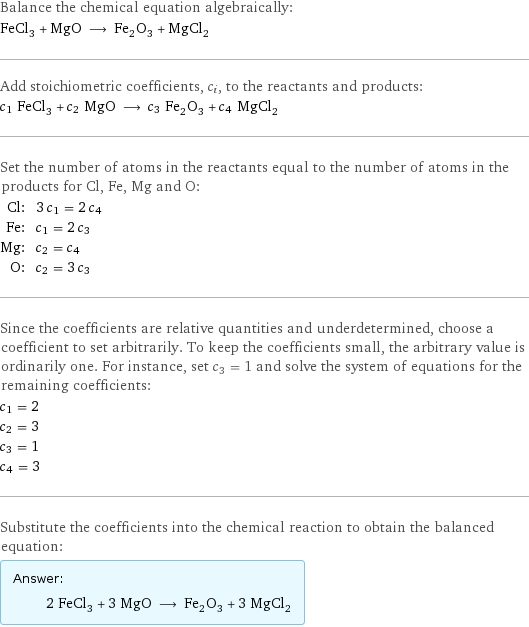
Balance the chemical equation algebraically: FeCl_3 + MgO ⟶ Fe_2O_3 + MgCl_2 Add stoichiometric coefficients, c_i, to the reactants and products: c_1 FeCl_3 + c_2 MgO ⟶ c_3 Fe_2O_3 + c_4 MgCl_2 Set the number of atoms in the reactants equal to the number of atoms in the products for Cl, Fe, Mg and O: Cl: | 3 c_1 = 2 c_4 Fe: | c_1 = 2 c_3 Mg: | c_2 = c_4 O: | c_2 = 3 c_3 Since the coefficients are relative quantities and underdetermined, choose a coefficient to set arbitrarily. To keep the coefficients small, the arbitrary value is ordinarily one. For instance, set c_3 = 1 and solve the system of equations for the remaining coefficients: c_1 = 2 c_2 = 3 c_3 = 1 c_4 = 3 Substitute the coefficients into the chemical reaction to obtain the balanced equation: Answer: | | 2 FeCl_3 + 3 MgO ⟶ Fe_2O_3 + 3 MgCl_2
Structures

+ ⟶ +
Names

iron(III) chloride + magnesium oxide ⟶ iron(III) oxide + magnesium chloride
Reaction thermodynamics
Enthalpy
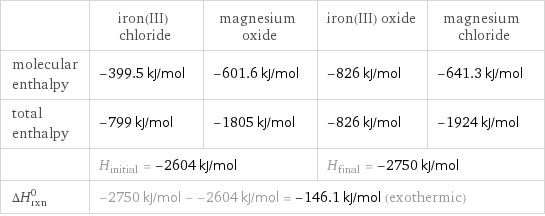
| iron(III) chloride | magnesium oxide | iron(III) oxide | magnesium chloride molecular enthalpy | -399.5 kJ/mol | -601.6 kJ/mol | -826 kJ/mol | -641.3 kJ/mol total enthalpy | -799 kJ/mol | -1805 kJ/mol | -826 kJ/mol | -1924 kJ/mol | H_initial = -2604 kJ/mol | | H_final = -2750 kJ/mol | ΔH_rxn^0 | -2750 kJ/mol - -2604 kJ/mol = -146.1 kJ/mol (exothermic) | | |
Gibbs free energy
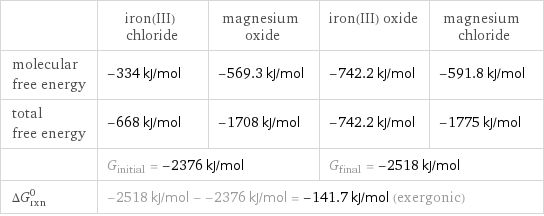
| iron(III) chloride | magnesium oxide | iron(III) oxide | magnesium chloride molecular free energy | -334 kJ/mol | -569.3 kJ/mol | -742.2 kJ/mol | -591.8 kJ/mol total free energy | -668 kJ/mol | -1708 kJ/mol | -742.2 kJ/mol | -1775 kJ/mol | G_initial = -2376 kJ/mol | | G_final = -2518 kJ/mol | ΔG_rxn^0 | -2518 kJ/mol - -2376 kJ/mol = -141.7 kJ/mol (exergonic) | | |
Equilibrium constant
![Construct the equilibrium constant, K, expression for: FeCl_3 + MgO ⟶ Fe_2O_3 + MgCl_2 Plan: • Balance the chemical equation. • Determine the stoichiometric numbers. • Assemble the activity expression for each chemical species. • Use the activity expressions to build the equilibrium constant expression. Write the balanced chemical equation: 2 FeCl_3 + 3 MgO ⟶ Fe_2O_3 + 3 MgCl_2 Assign stoichiometric numbers, ν_i, using the stoichiometric coefficients, c_i, from the balanced chemical equation in the following manner: ν_i = -c_i for reactants and ν_i = c_i for products: chemical species | c_i | ν_i FeCl_3 | 2 | -2 MgO | 3 | -3 Fe_2O_3 | 1 | 1 MgCl_2 | 3 | 3 Assemble the activity expressions accounting for the state of matter and ν_i: chemical species | c_i | ν_i | activity expression FeCl_3 | 2 | -2 | ([FeCl3])^(-2) MgO | 3 | -3 | ([MgO])^(-3) Fe_2O_3 | 1 | 1 | [Fe2O3] MgCl_2 | 3 | 3 | ([MgCl2])^3 The equilibrium constant symbol in the concentration basis is: K_c Mulitply the activity expressions to arrive at the K_c expression: Answer: | | K_c = ([FeCl3])^(-2) ([MgO])^(-3) [Fe2O3] ([MgCl2])^3 = ([Fe2O3] ([MgCl2])^3)/(([FeCl3])^2 ([MgO])^3)](../image_source/407ca14bad3dbe44f867431761e78d4b.png)
Construct the equilibrium constant, K, expression for: FeCl_3 + MgO ⟶ Fe_2O_3 + MgCl_2 Plan: • Balance the chemical equation. • Determine the stoichiometric numbers. • Assemble the activity expression for each chemical species. • Use the activity expressions to build the equilibrium constant expression. Write the balanced chemical equation: 2 FeCl_3 + 3 MgO ⟶ Fe_2O_3 + 3 MgCl_2 Assign stoichiometric numbers, ν_i, using the stoichiometric coefficients, c_i, from the balanced chemical equation in the following manner: ν_i = -c_i for reactants and ν_i = c_i for products: chemical species | c_i | ν_i FeCl_3 | 2 | -2 MgO | 3 | -3 Fe_2O_3 | 1 | 1 MgCl_2 | 3 | 3 Assemble the activity expressions accounting for the state of matter and ν_i: chemical species | c_i | ν_i | activity expression FeCl_3 | 2 | -2 | ([FeCl3])^(-2) MgO | 3 | -3 | ([MgO])^(-3) Fe_2O_3 | 1 | 1 | [Fe2O3] MgCl_2 | 3 | 3 | ([MgCl2])^3 The equilibrium constant symbol in the concentration basis is: K_c Mulitply the activity expressions to arrive at the K_c expression: Answer: | | K_c = ([FeCl3])^(-2) ([MgO])^(-3) [Fe2O3] ([MgCl2])^3 = ([Fe2O3] ([MgCl2])^3)/(([FeCl3])^2 ([MgO])^3)
Rate of reaction
![Construct the rate of reaction expression for: FeCl_3 + MgO ⟶ Fe_2O_3 + MgCl_2 Plan: • Balance the chemical equation. • Determine the stoichiometric numbers. • Assemble the rate term for each chemical species. • Write the rate of reaction expression. Write the balanced chemical equation: 2 FeCl_3 + 3 MgO ⟶ Fe_2O_3 + 3 MgCl_2 Assign stoichiometric numbers, ν_i, using the stoichiometric coefficients, c_i, from the balanced chemical equation in the following manner: ν_i = -c_i for reactants and ν_i = c_i for products: chemical species | c_i | ν_i FeCl_3 | 2 | -2 MgO | 3 | -3 Fe_2O_3 | 1 | 1 MgCl_2 | 3 | 3 The rate term for each chemical species, B_i, is 1/ν_i(Δ[B_i])/(Δt) where [B_i] is the amount concentration and t is time: chemical species | c_i | ν_i | rate term FeCl_3 | 2 | -2 | -1/2 (Δ[FeCl3])/(Δt) MgO | 3 | -3 | -1/3 (Δ[MgO])/(Δt) Fe_2O_3 | 1 | 1 | (Δ[Fe2O3])/(Δt) MgCl_2 | 3 | 3 | 1/3 (Δ[MgCl2])/(Δt) (for infinitesimal rate of change, replace Δ with d) Set the rate terms equal to each other to arrive at the rate expression: Answer: | | rate = -1/2 (Δ[FeCl3])/(Δt) = -1/3 (Δ[MgO])/(Δt) = (Δ[Fe2O3])/(Δt) = 1/3 (Δ[MgCl2])/(Δt) (assuming constant volume and no accumulation of intermediates or side products)](../image_source/6895e3d7673580bb826af9264036e881.png)
Construct the rate of reaction expression for: FeCl_3 + MgO ⟶ Fe_2O_3 + MgCl_2 Plan: • Balance the chemical equation. • Determine the stoichiometric numbers. • Assemble the rate term for each chemical species. • Write the rate of reaction expression. Write the balanced chemical equation: 2 FeCl_3 + 3 MgO ⟶ Fe_2O_3 + 3 MgCl_2 Assign stoichiometric numbers, ν_i, using the stoichiometric coefficients, c_i, from the balanced chemical equation in the following manner: ν_i = -c_i for reactants and ν_i = c_i for products: chemical species | c_i | ν_i FeCl_3 | 2 | -2 MgO | 3 | -3 Fe_2O_3 | 1 | 1 MgCl_2 | 3 | 3 The rate term for each chemical species, B_i, is 1/ν_i(Δ[B_i])/(Δt) where [B_i] is the amount concentration and t is time: chemical species | c_i | ν_i | rate term FeCl_3 | 2 | -2 | -1/2 (Δ[FeCl3])/(Δt) MgO | 3 | -3 | -1/3 (Δ[MgO])/(Δt) Fe_2O_3 | 1 | 1 | (Δ[Fe2O3])/(Δt) MgCl_2 | 3 | 3 | 1/3 (Δ[MgCl2])/(Δt) (for infinitesimal rate of change, replace Δ with d) Set the rate terms equal to each other to arrive at the rate expression: Answer: | | rate = -1/2 (Δ[FeCl3])/(Δt) = -1/3 (Δ[MgO])/(Δt) = (Δ[Fe2O3])/(Δt) = 1/3 (Δ[MgCl2])/(Δt) (assuming constant volume and no accumulation of intermediates or side products)
Chemical names and formulas
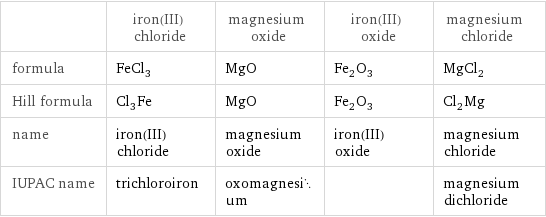
| iron(III) chloride | magnesium oxide | iron(III) oxide | magnesium chloride formula | FeCl_3 | MgO | Fe_2O_3 | MgCl_2 Hill formula | Cl_3Fe | MgO | Fe_2O_3 | Cl_2Mg name | iron(III) chloride | magnesium oxide | iron(III) oxide | magnesium chloride IUPAC name | trichloroiron | oxomagnesium | | magnesium dichloride
Substance properties
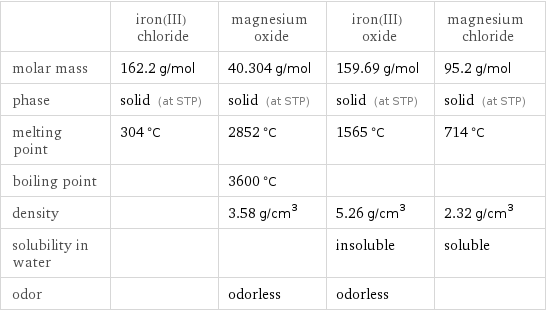
| iron(III) chloride | magnesium oxide | iron(III) oxide | magnesium chloride molar mass | 162.2 g/mol | 40.304 g/mol | 159.69 g/mol | 95.2 g/mol phase | solid (at STP) | solid (at STP) | solid (at STP) | solid (at STP) melting point | 304 °C | 2852 °C | 1565 °C | 714 °C boiling point | | 3600 °C | | density | | 3.58 g/cm^3 | 5.26 g/cm^3 | 2.32 g/cm^3 solubility in water | | | insoluble | soluble odor | | odorless | odorless |
Units
